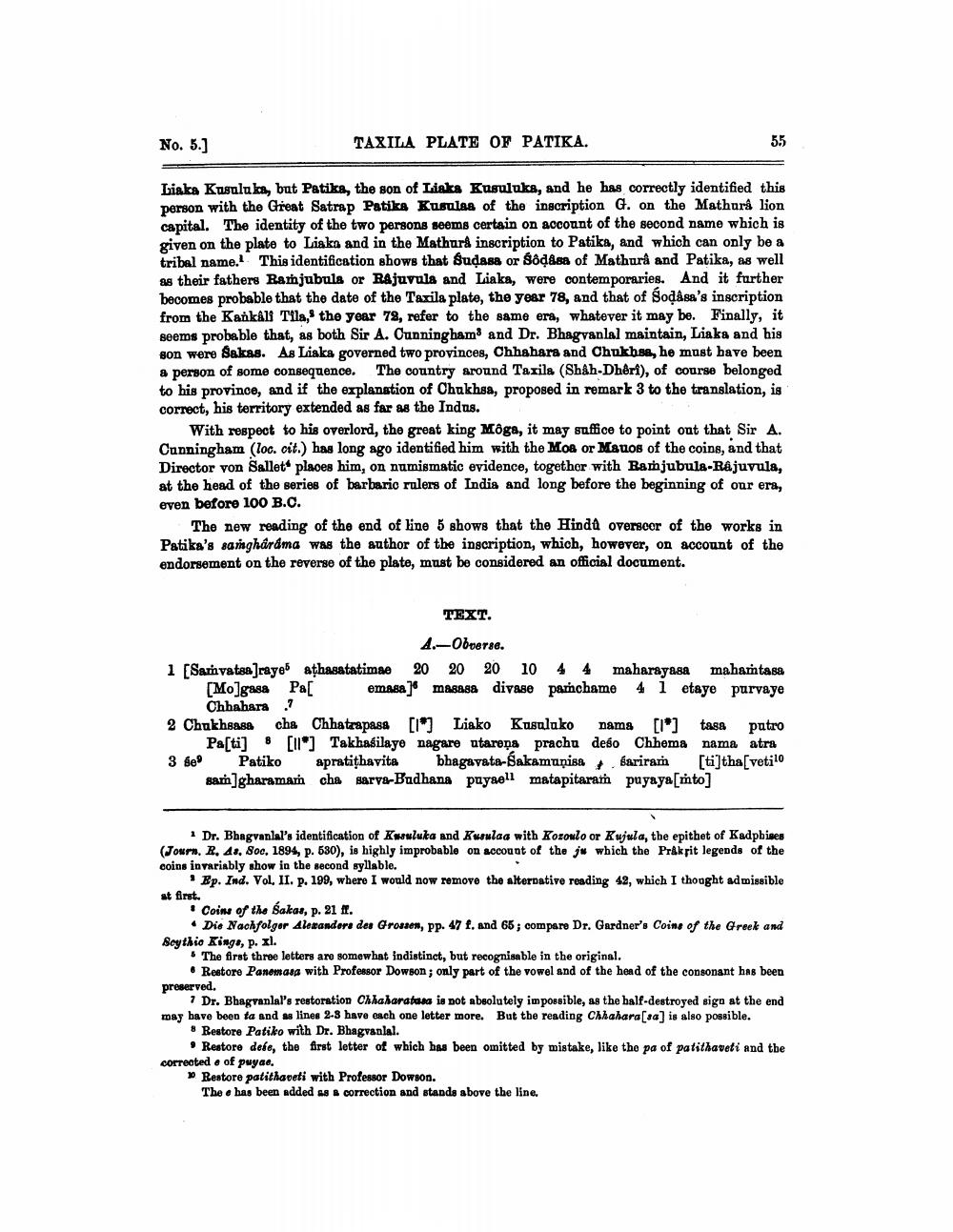________________
No. 5.]
TAXILA PLATE OF PATIKA.
Liaka Kusuluke, but Patike, the son of Links Kusuluka, and he has correctly identified this person with the Great Satrap Patika Kusulas of the inscription G. on the Mathura lion capital. The identity of the two persons seems certain on account of the second name which is given on the plate to Liaka and in the Mathura inscription to Patika, and which can only be a tribal name. This identification shows that Suasa or Sodasa of Mathura and Patika, as well ag their fathers Ramjubula or Rajuvula and Liaka, were contemporaries. And it further becomes probable that the date of the Taxila plate, the year 78, and that of Sodasa's inscription from the Kankalt Tila, the year 78, refer to the same era, whatever it may be. Finally, it seems probable that, as both Sir A. Cunningham and Dr. Bhagvanlal maintain, Liaka and his son were Sakas. As Liaka governed two provinces, Chhahara and Chukhsa, he must have been a person of some consequence. The country around Taxila (Shah-Dhørt), of course belonged to his province, and if the explanation of Chukhsa, proposed in remark 3 to the translation, is correct, his territory extended as far as the Indns.
With respect to his overlord, the great king Môga, it may suffice to point out that Sir A. Cunningham (loc. cit.) has long ago identified him with the Mos or Mauos of the coins, and that Director von Sallet places him, on numismatic evidence, together with Ramjubula-Râjuvula, at the head of the series of barbaric rulers of India and long before the beginning of our era, even before 100 B.C.
The new reading of the end of line 5 shows that the Hindu oversoor of the works in Patika's samgharama was the author of the inscription, which, however, on account of the endorsement on the reverse of the plate, must be considered an official document.
TEXT.
A.-Obrerse. i Samvatsarayeb athasatatimae 20 20 20 10 4 4 maharayaga mahamtasa
[Mo]gasa Pal emasa) masasa divase pamchame 41 etaye purvaye
Chhahara 7 2 Chukhsasa cha Chhatzapasa [19] Liako Kusaluko nama [1] tasa putro
Pasti] 8 [11] Takhasilaye nagare atarena prachu deso Chhema nama atra 3 se Patiko apratithavita bhagavata-Sakamaņisa Bariram [ti]thasvetilo
sam]gharamam cha sarva-Budhana puyaell matapitaram puyaya [mto]
1 Dr. Bhagvanlal's identification of Kwulukta and Kuulag with Kozoulo or Kujula, the epithet of Kadpbises (Journ, R. 43, Soc. 1894, p. 680), is highly improbable on account of the ju which the Pråkfit legends of the coins invariably show in the second syllable.
* Ep. Ind. Vol. II. p. 199, where I would now remove the alternative reading 42, which I thought admissible at first.
• Coins of the Sakas, p. 21 f.
• Die Nachfolger Alexanders des Grossen, pp. 47 f. and 65; compare Dr. Gardner's Coins of the Greek and Seythio Kings, p. xl.
The first three letters are somewhat indistinct, but recognisable in the original.
• Restore Panemasa with Professor Dowson; only part of the vowel and of the head of the consonant has been preserved.
7 Dr. Bhagvanlal's restoration Chhaharatana is not absolutely impossible, as the half-destroyed sige at the end may bave been ta and as lines 2-8 have each one letter more. But the reading Chhahara[sa] is also possible.
# Restore Patiko with Dr. Bhagvanlal.
Restore dele, the first letter of which has been omitted by mistake, like the pa of patithaveti and the corrected e of puyae.
Restore patithaveti with Professor Dowson. The e has been added as a correction and stands above the line.




